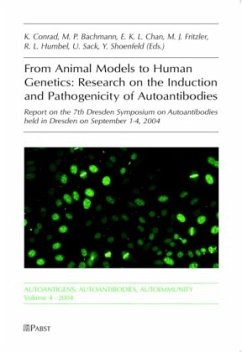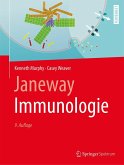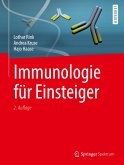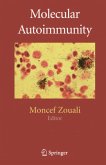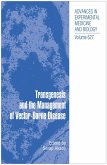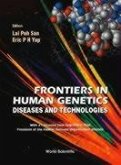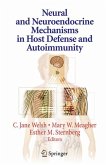The revolutionary techniques of modern molecular and cellular biology enhance almost daily our knowledge of immunity and autoimmunity in men and experimental animals. Our fragmentary puzzle of the immune system is going to form a fascinating picture of a master piece of evolution. Although many of these aspects were achieved by analysis of human body fluids and tissues, the etiopathogenesis of autoimmune diseases cannot readily be analyzed without appropriate animal models as shown in Chapter 1 and 3. Spontaneous and xenobiotic, idiotypic manipulation, and immunization induced autoimmune animal models as well as novel autoimmune knock-out and knock-in mice are used to investigate (i) the role in the pathogenesis of long-lived plasma cells, type I interferons, and mutations in genes encoding regulators of the cell cycle, (ii) the molecular mechanisms of xenobiotic autoimmunity, (iii) the break of tolerance via immunization with apoptotic material, (iv) immune mechanisms of autoimmune pregnancy loss as well as experimental APS, and (v) novel therapeutic approaches. This volume further deals with natural and pathogenic autoantibodies (Chapter 2), autoantibodies in systemic autoimmune diseases (Chapter 7), and the autoimmunity in neurological diseases. The role of B cells, auto-antibodies and post-translational modifications in the pathogenesis of multiple sclerosis is discussed (Chapter 6). Some human SLE susceptibility genes identified by linkage studies e.g. at 1q23, a novel RA susceptibility gene encoding peptidylarginine deiminase type 4 as well as novel auto-antibodies that target GW bodies, mitotic chromosomes, the spindle apparatus, hnRNPs, laminin-1, high mobility group box 1 protein, and the survival protein LEDGF/p75 are described in detail (Chapter 4,5). Furthermore, the occurrence and measurement of therapy-induced antibodies (Chapter 8), guidelines and approaches to autoantibody testing and new technologies in autoantibody profiling, such as addressable laser bead immuno-assays and autoantigen arrays are reviewed and discussed (Chapter 9).
Contents:
1. Pathogenesis and Therapy of Autoimmunity in Experimental Mouse Models
M.P. Bachmann, K. Conrad: Autoimmunity in men and mice: An introduction
M.P. Bachmann: Novel autoimmune models: lessons from recent transgenic and knock in animals
F. Hiepe, A. Radbruch, R.A. Manz: Long-lived plasma cells contribute to humoral autoimmunity
D.C. Nacionales, H. Zhuang, K.M. Kelly, S. Narain, J. Weinstein, M. Honkanen-Scott, H. B. Richards, E. Sobel, M. Satoh, W.H. Reeves: Innate immunity and interferon production in the pathogenesis of autoantibodies in lupus
M. Blank, Y. Shoenfeld: Autoimmune pregnancy loss - Experimental models
M. Miyazawa, E. Kajiwara, N. Tabata, T. Ogawa, T. Yuasa, H. Matsumura: Pathogenicity of autoantibodies reactive with the endogenous retroviral envelope glycoprotein gp70
F.F. Alcantara, E. Postol, E.R. Alencar, J. Kalil, L. Guilherme: Rheumatic Fever: an animal model for a human disease
J. Gentiletti, S.A. Jimenez, P. Christner: Demonstration of humoral autoimmunity in the tight skin-2 mouse: a model for systemic sclerosis
A. Musaji, M. Meite, L. Detalle, S. Franquin, F. Cormont, V. Préat, S. Izui, J.-P. Coutelier: Enhancement of autoantibody pathogenicity by viral infections in mouse models of anemia and thrombocytopenia
M. Bobeck, J. Cleary, G.D. Glick: Binding properties of a sequence-specific pathogenic Lupus antissDNA autoantibody
D. Huugen, H. Xiao, A. van Esch, C.J. Peutz-Kootstra, J.C. Jennette, J.W. Cohen Tervaert, P. Heeringa: The role of proinflammatory stimuli in the pathogenesis of MPOANCA associated vasculitis in a mouse model using MPO-deficient mice
Z. Pan, K. Davis, S. Maier, J. Workman, M.P. Bachmann, A.D. Farris: Syngeneic cells in late apoptosis mature DC in vivo and induce antibodies to dsDNA and neo-epitopes of La/SS-B in immunized mice
M. Blank, I. Nur, R. Meidler, L. Bar, L. Slutzki, B. Gilburd, Y. Shoenfeld: Peptide mimetics of anti-dsDNA idiotypes as a tool for Lupusspecific IVIG preparation: Specificity and efficacy in the treatment of experimental SLE
S. Werwitzke, D. Trick, K. Kamino, T. Matthias, K. Kniesch, B. Schlegelberger, R.E. Schmidt, T. Witte: IgM anti-dsDNA antibodies as a treatment of murine systemic Lupus erythematosus (SLE)
A. Tchorbanov, E. Voynova, N. Mihailova, T. Vassilev: Selective suppression of DNA-specific B cells in lupus mice by a chimeric antibody/peptide molecule
2. Natural and Pathogenic Autoantibodies
J. Bayry, N. Misra, A. Ephrem, A. Nicoletti, S. Lacroix-Desmazes, M.D. Kazatchkine, S.V. Kaveri: Beneficial aspects of natural autoantibodies
P.L. Meroni and Y. Shoenfeld: Receptors of the innate immunity as targets for circulating autoantibodies: antiphospholipid syndrome as a paradigm
G.A. Nevinsky: Catalytically active antibodies in patients with autoimmune diseases
3. Molecular Mechanisms of Xenobiotic-Induced Autoimmunity
K.M. Pollard, P. Hultman, M. Arnush, B. Hildebrandt, D.H. Kono: Immunology and genetics of xenobiotic-induced autoimmunity
A. von Mikecz: Xenobiotic-induced autoimmune responses and protein aggregation diseases share a common subnuclear pathology
M. Chen, A. Tanbajewa, A. Kuhn, T. Ruzicka, A. von Mikecz: Proteasomal-dependent antigen processing of topoisomerase I in scleroderma
A. Scharf, M. Chen, A. von Mikecz: The immunotoxin mercury chloride induces specific alterations in the cell nucleus
S. Havarinasab, B. Häggqvist, E. Björn, K.M. Pollard, P. Hultman: Exposure to the organic mercury compound thimerosal leads to immunosuppression followed by systemic autoimmunity
K. Martinsson, P. Hultman: The importance of Fc-receptors in mercury-induced autoimmunity
H. Ohmori, M. Oka, H. Shigemitsu, Y. Nishikawa, M. Takeuchi, M. Magari, N. Kanayama: An autoimmune response to tyrosine-nitrated autologous IgG: immunogenicity of a self protein bearing the inflammationassociated marker
4. Genetic Factors and Autoimmunity
B. Namjou, K.M. Kaufman, J. Kilpatrick, J.A. Kelly, J.B. Harley: Genetic Linkage and association at 1q23 in SLE
R. Yamada, A. Suzuki, X. Chang, K. Yamamoto: Peptidylarginine deiminase type 4: Identification of a rheumatoid arthritis susceptible gene
I. Senkpiehl, M. Marget, M. Wedler, S. Jenisch, J. Georgi, D. Kabelitz, J. Steinmann: Anti-cyclic citrullinated peptide antibody production in rheumatoid arthritis is controlled by HLA-DRB1
J. Cabiedes, M. Languren, B. Becerril, L.E. Fernández-Altuna, V. Pascual, D. Alarcón-Segovia, A.R. Cabral: Gene identification of single chain format variable (scFv) anti-ß2-Glycoprotein-I (aß2GP-I) and anti-prothrombin (aPt) antibodies obtained from a primary anti-phospholipid syndrome (PAPS) patient by phage display
I. Guseva, A. Gelonkina, E. Luchihina, M. Ivanova, V. Myakotkin: The contribution of Fc?RIIIA and interleukin 10 (IL-10) gene promoter polymorphisms to genetic susceptibility of systemic lupus erythematosus (SLE) and lupus nephritis in Russian population
5. Novel Autoantibodies of Pathogenetic and/or Clinical Relevance
E.K.L. Chan: Autoantibody target GW bodies - cytoplasmic foci of mRNA decay and regulatory functions
T.A. Brown-Bryan, T. Daniels, C.A. Casiano: Autoimmunity to the survival protein LEDGF/p75 in inflammatory disorders and cancer: Clinical and biological aspects
R.L. Humbel: Autoantibodies to mitotic chromosomes and spindle apparatus
G. Steiner, A. Belisova, A. Valai, S.Hayer, E. Höfler, J. Smolen: Reflections about structure, function and pathogenetic significance of Ro ribonucleoproteins
J. Inagaki, A. Kondo, L.R. Lopez, Y. Shoenfeld, E. Matsuura: Anti-laminin-1 autoantibodies in reproductive failure: animal and human studies
T. Uchimura, S. Yamada, K. Inoue, Y. Motomiya, T. Hashiguchi, I. Maruyama: False-positive perinuclear antineutrophil cytoplasmic antibody (P-ANCA) in hemodialysis patients and analysis of their target antigens
G. Zandman-Goddard, M. Blank, P. Langevitz, M. Pras, Y. Levy, T. Witte, A. Doria, J. Rovensky, Y. Shoenfeld: Elevated anti-serum amyloid component P (SAP) antibodies in SLE patients correlate with disease activity
G. Burguera, K. Adolph, A. Förster, G. Riemekasten, G.R. Burmester, K. Skriner: Autoantibodies to hnRNP-A1 in neuropsychiatric Lupus and other neurological diseases
K. Adolph, A. Sternjak, A. Förster, G. Steiner, G.R. Burmester, K. Skriner: The 40/38 kDa hnRNP-A3, a component of the mRNA transport particle, is a novel autoantigen in patients with systemic rheumatic diseases
E. Jimenez-Boj, N. Kedersha, M. Tohidast-Akrad, F. Karlhofer, G. Stummvoll, C. Zimmermann, E. Höfler, S. Hayer, G. Schett, P. Anderson, J. Smolen, G. Steiner: The translational suppressors TIA-1 and TIAR are targeted by autoantibodies and are overexpressed in inflamed skin of lupus patients
I. Wichmann, R. Magariño, I. Magariño, A. Torres, N. Respaldiza, M. Encarnación, A. Fernández-Suarez, A. Nuñez-Roldán: Clinical correlations of anti-CENP-F antibodies in a cohort of patients from Southern Spain
I. Wichmann, I. Aguilera, J.M. Sousa, A. Bernardos, J.R. García-Lozano, A. Núñez-Roldán: Presence of antibodies against GSTT1 (glutathion S-transferase T1) in non-transplanted patients
6. Humoral Autoimmunity in Neurological Diseases
T. Ziemssen: B cells and antibodies in demyelinating diseases like multiple sclerosis
R. Raijmakers, W.J. van Venrooij, G.J.M. Pruijn: Autoimmunity and post-translational modifications in multiple sclerosis
F. Blaes, K. Schmitz, M. Tschernatsch, O. Matz, M. Kaps, M. Bräu: Complex regional pain syndrome (M. Sudeck) is associated with autoantibodies against autonomic nervous system structures
M. Cojocaru, I.M. Cojocaru, D. Iordanescu: Association between circulating C1q- and C3d-immune complexes and the course of Alzheimer's disease
I.M. Malbohan, A. Bartos, L. Fialová, J. Soukupová, J. Kozeny: IgG and IgM antibodies to neurofilaments in patients with multiple sclerosis
N.M. van Sorge, L.H. van den Berg, M.D. Jansen, J.G.J. van de Winkel, N. Yuki, W-L. van der Pol: Anti-glycolipid IgG functionality predicts clinical symptoms in a Guillain-Barré syndrome animal model
U. Wurster, R.B. Lindert, I. Torens, F. Heidenreich: Frequencies of anti-MOG IgG autoantibodies in serum and cerebrospinal fluid of patients with multiple sclerosis depend on the nature of the antigen and western blotting assay conditions
7. Autoantibodies in Systemic Autoimmune Diseases
M. Reichlin: Autoimmunity: Past, present and future
7.1 Autoantibodies in Rheumatoid Arthritis
A.J.W. Zendman, E.R. Vossenaar, W.J. van Venrooij, G.J.M. Pruijn: Anti-CCP antibody - a specific and early marker for rheumatoid arthritis
V.P.K. Nell, K.P. Machold, T.A. Stamm, G. Eberl, W. Hueber, M. Uffmann, J.S. Smolen, G. Steiner: The diagnostic and prognostic significance of autoantibodies in patients with very early rheumatoid arthritis
K. Adolph, F. Schumann, P. Jungblut, G.R. Burmester, K. Skriner: Immunomic analysis of synovial fluid exosomes reveals cirullinated proteins in patients with rheumatoid arthritis
M.B. Spellerberg, K.K. Solanki, P.T Chapman, P.W. Moller, J.L. O`Donnell: Anti-CCP antibodies: Diagnostic sensitivity in Canterbury health laboratories
I.E.A. Hoffman, B.V. Cruyssen, H. Zmierczak, M. Vandenberghe, E. Kruithof, L. De Rycke, D. Baeten, H. Mielants, E.M. Veys, F. De Keyser: Anti-CCP antibodies may occur in patients with true psoriatic
rthritis
I.E.A. Hoffman, P. Dewint, S. Rogge, R. Joos, J. Dehoorne, A. Union, E.M. Veys, F. De Keyser, D. Elewaut: Low prevalence of anti-citrullinated peptide antibodies in polyarticular juvenile idiopathic arthritis
L. Nogueira, A. Foussadier, A. Constantin, C. Clavel, C. Vincent, A. Cantagrel, M. Jolivet, G. Serre: VIDAS-EDRA: the first automated testing for autoantibodies to citrullinated proteins
I. Hromadnikova I, D. Zlacka, H. Nguyen, P. Vavrincova: Antibodies to recombinant human 60 kDa heat shock protein in sera of patients with juvenile idiopathic arthritis
L. Sedlackova, P. Vavrincova, J. Velek, I. Hromadnikova: Cell responses to heat shock proteins 60, 65, 70 and synthetic hspderived peptides in patients with juvenile idiopathic arthritis
7.2 Autoantibodies in SLE
N. Bizzaro, D. Villalta, E. Tonutti, R. Tozzoli , S. Zampieri, A. Ghirardello, A. Doria: The diagnostic and prognostic role of anti-C1q Antibodies in SLE
N. Miehle, F. Petschner, B. Nettlenbusch, S. Bartschat-Dominke, U.A. Walker, K. Warnatz, M. Schlesier, H.H. Peter: Anti-C1q antibodies in Lupus nephritis
M. Mahler, M.J. Fritzler, M. Blüthne: Identification and characterization of a SLE specific SmD3 mimotope peptide
R. Tozzoli, G. Kodermaz, N. Bizzaro, D. Villalta, E. Tonutti, A. Ghirardello, A. Doria: Diagnostic accuracy of the SmD183-117 antibody immunoassay in SLE
M. Mahler, K. Kessenbrock, M. Szmyrka, P. Höpfl, M.J. Fritzler: Improved detection of autoantibodies to the three ribosomal P proteins
I. Kostic, R. Petrovic, M. Bukilica, S. Zivancevic-Simonovic: Thyroid autoantibodies in patients with systemic lupus erythematosus and rheumatoid arthritis
P. Großmann, V. Gerl, C. Johnen, B. Hostmann, K. Bräutigam, N. Toman, F.-W. von Hesler, A. Radbruch, F. Hiepe: TNF-alpha-induced surface expression of 52 kDa Ro/SS-A autoantigen is not sufficient for induction of ADCC in normal human keratinocytes.
D. Kozáková, V. Bosák, L. Cebecauer, J. Lukác, J. Rovensky: Antinuclear and lymphocytotoxic autoantibodies in SLE: does ANA act as lymphocytotoxic antibodies?
V. Gerl, P. Großmann, D. Panne, M. Gerl, A. Waka, B. Hostmann, K. Reiter, J. Kaufmann, A. Jacobi, T. Alexander, A. Radbruch, F. Hiepe: CD11c high expressing dendritic cells (DCs) are upregulated in SLE
7.3 Autoantibodies in Systemic Sclerosis, Myositis and Overlap Syndromes
T. Prestigiacomo, M. Watkins, S.R. Binder: Anti-topoisomerase I (anti-Scl-70) autoantibodies are specific to scleroderma and are not present in patients with SLE
G.J.M. Pruijn, D. Hof, K. Cheung, W.J. van Venrooij, J.M.H. Raats: Autoimmune sera preferentially recognize the apoptotic 40 kDa fragment of the U1-70K antigen
R. Raijmakers, M. Renz, C. Wiemann, W.V. Egberts, H.P. Seelig, W.J. van Venrooij, G.J.M. Pruijn: PM/Scl-75 is the main autoantigen in patients with the polymyositis/scleroderma overlap syndrome
B. Roch, K. Conrad, Uta Kießling, A.K. Menzel, M.P. Bachmann, H.E. Schröder: Autoantibodies reacting with antigen(s) of the cleavage furrow and the midbody region - specific for patients of the systemic sclerosis spectrum ?
S. Ahmed: Exploring the role of caspase-3 in human dermal endothelial cell apoptosis induced by scleroderma serum
7.4 Autoantibodies in Sjögren's Syndrome
T. Sumida, Y. Naito, E. Wakamatsu, D. Goto, S. Ito, A. Tsutsumi, I. Matsumoto: Autoantibodies against M3 muscarinic acetylcholine receptors in patients with Sjögren's syndrome
P. Zigon, S. Cucnik, B. Bozic, B. Rozman, M. Plesivcnik - Novljan, M. Tomsic, T. Kveder: Antibodies against 25-mer synthetic peptide of M3 muscarinic acetylcholine receptor in patients with Sjögren's syndrome and SLE
N. Bizzaro, D. Villalta, E. Tonutti, R. Tozzoli: Anti-??fodrin antibodies in patients with primary Sjögren's
syndrome: poor analytical sensitivity or low nosographic prevalence?
H. Locht, R. Pelck, M. Høier Madsen, A. Wiik, R. Manthorpe: Patterns of anti-nuclear antibodies (ANA) among patients with primary Sjögren's syndrome with correlation to internal organ affection
R. Pelck, H. Locht, R. Manthorpe: Anti-La (SSB) autoantibodies are strongly associated with internal organ damage in patients with primary Sjögren's syndrome
7.5 Autoantibodies in Atherosclerosis, Recurrent Miscarriages and Antiphospholipid Syndrome
E. Matsuura, K. Kobayashi, Y. Shoenfeld, L.R. Lopez: Atherogenic role of protein-modified oxidized low-density lipoproteins and their autoantibodies
I. Marai, Y. Shoenfeld: Autoantibodies and recurrent miscarriages
C. Buschmann, C. Fischer, A. Stachl, K.J. Lackner, P. von Landenberg: Identification of a peptide mimicing the binding pattern of anti-Cardiolipin antibodies
Z. Vanková, K. Malícková, T. Fucíková, I. Janatková, H. Marecková: The clinical significance of the determination of antiphospholipid antibodies - a retrospective study
S. Cucnik, T. Kveder, B. Rozman, B. Bozic: Heterogeneous avidity of anti-?2-glycoprotein I antibodies
8. Therapy-induced Antibodies
H. Schellekens, A. Kromminga: Antibodies against protein based therapeutics - an overview
E. Blanvillain, B. Parmentier, D. Boucaud-Maitre, S. Nancey, B. Flourié, A. Moreira, J. Bienvenu, N. Fabien: Infliximab therapy in Crohn's disease induced autoantibodies restricted to antinuclear and anti-doublestranded DNA autoantibodies without autoimmune clinical manifestations
L. De Rycke, E. Kruithof, F. Van den Bosch, I.E.A Hoffman, E.M. Veys, D. Baeten, F. De Keyser: Anti-nuclear antibody profiles during infliximab and etanercept treatment in spondyloarthropathy: Is induction of humoral autoimmunity by TNF-alpha blockade a class effect?
9. Methodical Aspects and Diagnostic Strategies
A. Wiik: Guidelines and approaches to autoantibody testing
9.1 Multiplex Assays for Autoantibody Profiling
M.J. Fritzler: New technologies in the detection of autoantibodies: Evaluation of addressable laser bead immunoassays (ALBIA)
T. Prestigiacomo, R.L. Humbel, B. Larida, S.R. Binder: Multiplexed analysis of thirteen autoantibodies using the BioPlex(tm) 2200 fully automated immunoassay analyzer
I. Abreu, A. Bastos, C. Cardoso, H. Ribeiro, N. Couceiro, A. Bodas, A.M. Pereira, J. Candeias, J.A.M. Caetano: Multicentre evaluation of the new multiplex assay FIDIS Connective. Comparison with convencional methods
R. Tozzoli, G. Kodermaz, N. Bizzaro, D. Villalta, E. Tonutti, A. Ghirardello, A. Doria: Sensitivity and specificity of the FIDIS multiplex immunoassay system for the detection of dsDNA and nuclear specific antibodies in autoimmune rheumatic diseases
I. Lochman, A. Kloudova, J. Lupac: Comparison of two multiplex assays for anti-ENA/ANA determination
P.J. Utz, S.M. Chan: Autoantibody profiling and lymphocyte characterization using autoantigen and lysate arrays
Ch. Hentschel, W. Schoessler, J. Schulte-Pelkum, J. Kreutzberger, F. Hiepe: Development of a sensitive and reliable biochip for detection of autoantibodies in rheumatic diseases
T. Lüttich, M. Sticherling, D. Scholz, K. Hennig, P. Eißfeller, M. Motz, A. Kromminga: Comparison of different test systems for simultaneous autoantibody detection
9.2 Antinuclear Antibodies
P.G. Leser, A. Dellavance, S.H. Barbosa, G. Guis, S.H. Rodrigues, E.I. Sato, L.E.C. Andrade: Distinctive features of antinuclear antibodies observed in health and in subjects with autoimmune rheumatic diseases
N. Werner, R.L. Humbel: IgG, IgA, and IgM isotypes of anti-nuclear/-cytoplasmic antibodies
P. Perner, H. Perner, R. Sonntag: An image inspection system for the automatic classification of HEp-2 cell patterns
D. Hamann, P. Charles, M. Renz, H.P. Seelig, A. Wiik, R.J.T. Smeenk: Results of the European Consensus Finding Study Group on Autoantibodies (March 2003 - March 2004)
W. Meyer, T. Scheper, M. Siegemund, K. Takeuchi, W. Schlumberger, W. Stöcker: The SS-A/Ro 60 kDa protein is sufficient for the detection of autoantibodies against SS-A
R. Burlingame, A. Piette, C. Peebles, C. von Muhlen, R. Williams, M. Fritzler, P. Charles, K.M. Pollard, N. Fertig, C. Watkins, C. Oddis: The clinical sensitivities and specificities of anti-SSA-52 (Ro-52) and anti-SSA-60 (Ro60) autoantibodies are dependent on the techniques used to detect them
V. Král, I. Stiborová, D. Jílek: The optimal anti-dsDNA antibody test strategy for the routine immunological laboratory?
J. Litzman, P. Nemec, V. Thon, J. Lokaj: Autoantibodies in two patients with selective IgM deficiency
9.3 ANCA
J.G.M.C. Damoiseaux, J. Austen, M.C. Slot, M. Vaessen, C.A. Stegeman, P. van Paassen, J.W. Cohen Tervaert: Evaluation of a new fluorescent-enzyme immuno-assay for diagnosis and follow-up of ANCA-associated vasculitis
C. Daehnrich, W. Schlumberger, C. Lehmann, W. Stöcker: A newly developed anti-PR3 Capture ELISA shows a higher correlation to positive cANCA results and a better serological hit rate than a direct anti-PR3 ELISA
T. Uchimura, Y. Motomiya, T. Hashiguchi, K. Inoue, S. Yamada, I. Maruyama: High mobility group box-1 (HMGB-1) is a major target antigen of perinuclear anti-neutrophil cytoplasmic antibodies (pANCA) in maintenance hemodialysis patients
9.4 Diagnosis and Prediction of Organ-specific Autoimmune Diseases
L. Komorowski, S. Mindorf, B. Teegen, S. Torkler, W. Stoecker: Diagnosis of goblet cell antibodies in ulcerative colitis by using the cell line HT29-18N2 as antigenic substrate
M. Cojocaru, I.M. Cojocaru: Anti-intestinal goblet cell antibodies in ulcerative colitis
E. Tonutti, M. Poletto, D. Visentini, R. Maieron, M. Zilli, N. Bizzaro: The role of ASCAs in the diagnosis of Crohn's disease: Evidence for a wide variability of commercial methods and for a high prevalence in celiac patients
N. Virstyuk, E. Neyko, M. Orynchak, V. Neyko: The autoimmune reactions in patients with inflammatory bowel disease with rheumatic manifestations
M. Stern, A. Patel, G. Blumenstock, T. Mothes, O. Bauer, M. Renz, H.P. Seelig: Comparison of the diagnostic accuracy of three methods to detect celiac disease
D. Villalta, S. Platzgummer, M. Liguori, M. Tampoia, A. Baragiotta, E. Tonutti, R. Tozzoli , N. Bizzaro: The diagnostic accuracy of anti-actin antibody detection by immunoblot, ELISA and indirect immunofluorescence methods in patients with autoimmune hepatitis
C. Krueger, H. Brooking, B.R. Smith, W. Stoecker: New ELISA for determination of glutamic acid decarboxylase (GAD65) autoantibodies in type 1 diabetes mellitus
M. Schlosser, M. Strebelow, I. Rjasanowski, R. Wassmuth, W. Kerner: Stratification of type 1 diabetes risk on the basis of islet autoantibody characteristics in the general population - The Karlsburg Type 1 Diabetes risk study
R. Tozzoli, G. Kodermaz, M. Tampoia, N. Bizzaro, A. Tedesco, D. Villalta, E. Tonutti: Heat shock protein 70 (hsp70) antibodies in immuno-mediated inner ear diseases
9.5 Miscellaneous Investigation
I. Lochman, V. Krauz: The role of anti-IgE autoantibodies in diagnosis of IgE mediated diseases
Y.L. Lee, C.M. Shih, H.L. Chiou, M.Y. Shiau, G.C. Chang, Y.H.Chang: Alteration of autoantibodies against p53 in Taiwanese lung cancer patients undergoing chemotherapy
Y.L. Lee, L. Wang, C.M. Shih, Y.H. Chang, H.L. Chiou, G.H. Shen, M.Y. Shiau: Autoantibodies against tumor suppressor protein p53 in pleural effusions of patients with tuberculosis pleurisy
M. Latalski, M. Koziol-Montewka, A. Gregosiewicz, M. Tokarska-Rodak, T. Raganowicz, G. Kandzierski: Immunological aspect of Perthes' disease and slipped capital femoral epiphysis in children - antiphospholipid antibodies
A. Bossowski, A. Stasiak-Barmuta, B. Czarnocka, M. Urban, A.P. Weetman, M. Niedziela, E. Korman, J. Dadan: Cytofluorimetric analysis of apoptosis markers CD95/CD95L (Fas/FasL) in thyroid tissues from young patients with Graves' disease and Hashimoto's thyroiditis
Contents:
1. Pathogenesis and Therapy of Autoimmunity in Experimental Mouse Models
M.P. Bachmann, K. Conrad: Autoimmunity in men and mice: An introduction
M.P. Bachmann: Novel autoimmune models: lessons from recent transgenic and knock in animals
F. Hiepe, A. Radbruch, R.A. Manz: Long-lived plasma cells contribute to humoral autoimmunity
D.C. Nacionales, H. Zhuang, K.M. Kelly, S. Narain, J. Weinstein, M. Honkanen-Scott, H. B. Richards, E. Sobel, M. Satoh, W.H. Reeves: Innate immunity and interferon production in the pathogenesis of autoantibodies in lupus
M. Blank, Y. Shoenfeld: Autoimmune pregnancy loss - Experimental models
M. Miyazawa, E. Kajiwara, N. Tabata, T. Ogawa, T. Yuasa, H. Matsumura: Pathogenicity of autoantibodies reactive with the endogenous retroviral envelope glycoprotein gp70
F.F. Alcantara, E. Postol, E.R. Alencar, J. Kalil, L. Guilherme: Rheumatic Fever: an animal model for a human disease
J. Gentiletti, S.A. Jimenez, P. Christner: Demonstration of humoral autoimmunity in the tight skin-2 mouse: a model for systemic sclerosis
A. Musaji, M. Meite, L. Detalle, S. Franquin, F. Cormont, V. Préat, S. Izui, J.-P. Coutelier: Enhancement of autoantibody pathogenicity by viral infections in mouse models of anemia and thrombocytopenia
M. Bobeck, J. Cleary, G.D. Glick: Binding properties of a sequence-specific pathogenic Lupus antissDNA autoantibody
D. Huugen, H. Xiao, A. van Esch, C.J. Peutz-Kootstra, J.C. Jennette, J.W. Cohen Tervaert, P. Heeringa: The role of proinflammatory stimuli in the pathogenesis of MPOANCA associated vasculitis in a mouse model using MPO-deficient mice
Z. Pan, K. Davis, S. Maier, J. Workman, M.P. Bachmann, A.D. Farris: Syngeneic cells in late apoptosis mature DC in vivo and induce antibodies to dsDNA and neo-epitopes of La/SS-B in immunized mice
M. Blank, I. Nur, R. Meidler, L. Bar, L. Slutzki, B. Gilburd, Y. Shoenfeld: Peptide mimetics of anti-dsDNA idiotypes as a tool for Lupusspecific IVIG preparation: Specificity and efficacy in the treatment of experimental SLE
S. Werwitzke, D. Trick, K. Kamino, T. Matthias, K. Kniesch, B. Schlegelberger, R.E. Schmidt, T. Witte: IgM anti-dsDNA antibodies as a treatment of murine systemic Lupus erythematosus (SLE)
A. Tchorbanov, E. Voynova, N. Mihailova, T. Vassilev: Selective suppression of DNA-specific B cells in lupus mice by a chimeric antibody/peptide molecule
2. Natural and Pathogenic Autoantibodies
J. Bayry, N. Misra, A. Ephrem, A. Nicoletti, S. Lacroix-Desmazes, M.D. Kazatchkine, S.V. Kaveri: Beneficial aspects of natural autoantibodies
P.L. Meroni and Y. Shoenfeld: Receptors of the innate immunity as targets for circulating autoantibodies: antiphospholipid syndrome as a paradigm
G.A. Nevinsky: Catalytically active antibodies in patients with autoimmune diseases
3. Molecular Mechanisms of Xenobiotic-Induced Autoimmunity
K.M. Pollard, P. Hultman, M. Arnush, B. Hildebrandt, D.H. Kono: Immunology and genetics of xenobiotic-induced autoimmunity
A. von Mikecz: Xenobiotic-induced autoimmune responses and protein aggregation diseases share a common subnuclear pathology
M. Chen, A. Tanbajewa, A. Kuhn, T. Ruzicka, A. von Mikecz: Proteasomal-dependent antigen processing of topoisomerase I in scleroderma
A. Scharf, M. Chen, A. von Mikecz: The immunotoxin mercury chloride induces specific alterations in the cell nucleus
S. Havarinasab, B. Häggqvist, E. Björn, K.M. Pollard, P. Hultman: Exposure to the organic mercury compound thimerosal leads to immunosuppression followed by systemic autoimmunity
K. Martinsson, P. Hultman: The importance of Fc-receptors in mercury-induced autoimmunity
H. Ohmori, M. Oka, H. Shigemitsu, Y. Nishikawa, M. Takeuchi, M. Magari, N. Kanayama: An autoimmune response to tyrosine-nitrated autologous IgG: immunogenicity of a self protein bearing the inflammationassociated marker
4. Genetic Factors and Autoimmunity
B. Namjou, K.M. Kaufman, J. Kilpatrick, J.A. Kelly, J.B. Harley: Genetic Linkage and association at 1q23 in SLE
R. Yamada, A. Suzuki, X. Chang, K. Yamamoto: Peptidylarginine deiminase type 4: Identification of a rheumatoid arthritis susceptible gene
I. Senkpiehl, M. Marget, M. Wedler, S. Jenisch, J. Georgi, D. Kabelitz, J. Steinmann: Anti-cyclic citrullinated peptide antibody production in rheumatoid arthritis is controlled by HLA-DRB1
J. Cabiedes, M. Languren, B. Becerril, L.E. Fernández-Altuna, V. Pascual, D. Alarcón-Segovia, A.R. Cabral: Gene identification of single chain format variable (scFv) anti-ß2-Glycoprotein-I (aß2GP-I) and anti-prothrombin (aPt) antibodies obtained from a primary anti-phospholipid syndrome (PAPS) patient by phage display
I. Guseva, A. Gelonkina, E. Luchihina, M. Ivanova, V. Myakotkin: The contribution of Fc?RIIIA and interleukin 10 (IL-10) gene promoter polymorphisms to genetic susceptibility of systemic lupus erythematosus (SLE) and lupus nephritis in Russian population
5. Novel Autoantibodies of Pathogenetic and/or Clinical Relevance
E.K.L. Chan: Autoantibody target GW bodies - cytoplasmic foci of mRNA decay and regulatory functions
T.A. Brown-Bryan, T. Daniels, C.A. Casiano: Autoimmunity to the survival protein LEDGF/p75 in inflammatory disorders and cancer: Clinical and biological aspects
R.L. Humbel: Autoantibodies to mitotic chromosomes and spindle apparatus
G. Steiner, A. Belisova, A. Valai, S.Hayer, E. Höfler, J. Smolen: Reflections about structure, function and pathogenetic significance of Ro ribonucleoproteins
J. Inagaki, A. Kondo, L.R. Lopez, Y. Shoenfeld, E. Matsuura: Anti-laminin-1 autoantibodies in reproductive failure: animal and human studies
T. Uchimura, S. Yamada, K. Inoue, Y. Motomiya, T. Hashiguchi, I. Maruyama: False-positive perinuclear antineutrophil cytoplasmic antibody (P-ANCA) in hemodialysis patients and analysis of their target antigens
G. Zandman-Goddard, M. Blank, P. Langevitz, M. Pras, Y. Levy, T. Witte, A. Doria, J. Rovensky, Y. Shoenfeld: Elevated anti-serum amyloid component P (SAP) antibodies in SLE patients correlate with disease activity
G. Burguera, K. Adolph, A. Förster, G. Riemekasten, G.R. Burmester, K. Skriner: Autoantibodies to hnRNP-A1 in neuropsychiatric Lupus and other neurological diseases
K. Adolph, A. Sternjak, A. Förster, G. Steiner, G.R. Burmester, K. Skriner: The 40/38 kDa hnRNP-A3, a component of the mRNA transport particle, is a novel autoantigen in patients with systemic rheumatic diseases
E. Jimenez-Boj, N. Kedersha, M. Tohidast-Akrad, F. Karlhofer, G. Stummvoll, C. Zimmermann, E. Höfler, S. Hayer, G. Schett, P. Anderson, J. Smolen, G. Steiner: The translational suppressors TIA-1 and TIAR are targeted by autoantibodies and are overexpressed in inflamed skin of lupus patients
I. Wichmann, R. Magariño, I. Magariño, A. Torres, N. Respaldiza, M. Encarnación, A. Fernández-Suarez, A. Nuñez-Roldán: Clinical correlations of anti-CENP-F antibodies in a cohort of patients from Southern Spain
I. Wichmann, I. Aguilera, J.M. Sousa, A. Bernardos, J.R. García-Lozano, A. Núñez-Roldán: Presence of antibodies against GSTT1 (glutathion S-transferase T1) in non-transplanted patients
6. Humoral Autoimmunity in Neurological Diseases
T. Ziemssen: B cells and antibodies in demyelinating diseases like multiple sclerosis
R. Raijmakers, W.J. van Venrooij, G.J.M. Pruijn: Autoimmunity and post-translational modifications in multiple sclerosis
F. Blaes, K. Schmitz, M. Tschernatsch, O. Matz, M. Kaps, M. Bräu: Complex regional pain syndrome (M. Sudeck) is associated with autoantibodies against autonomic nervous system structures
M. Cojocaru, I.M. Cojocaru, D. Iordanescu: Association between circulating C1q- and C3d-immune complexes and the course of Alzheimer's disease
I.M. Malbohan, A. Bartos, L. Fialová, J. Soukupová, J. Kozeny: IgG and IgM antibodies to neurofilaments in patients with multiple sclerosis
N.M. van Sorge, L.H. van den Berg, M.D. Jansen, J.G.J. van de Winkel, N. Yuki, W-L. van der Pol: Anti-glycolipid IgG functionality predicts clinical symptoms in a Guillain-Barré syndrome animal model
U. Wurster, R.B. Lindert, I. Torens, F. Heidenreich: Frequencies of anti-MOG IgG autoantibodies in serum and cerebrospinal fluid of patients with multiple sclerosis depend on the nature of the antigen and western blotting assay conditions
7. Autoantibodies in Systemic Autoimmune Diseases
M. Reichlin: Autoimmunity: Past, present and future
7.1 Autoantibodies in Rheumatoid Arthritis
A.J.W. Zendman, E.R. Vossenaar, W.J. van Venrooij, G.J.M. Pruijn: Anti-CCP antibody - a specific and early marker for rheumatoid arthritis
V.P.K. Nell, K.P. Machold, T.A. Stamm, G. Eberl, W. Hueber, M. Uffmann, J.S. Smolen, G. Steiner: The diagnostic and prognostic significance of autoantibodies in patients with very early rheumatoid arthritis
K. Adolph, F. Schumann, P. Jungblut, G.R. Burmester, K. Skriner: Immunomic analysis of synovial fluid exosomes reveals cirullinated proteins in patients with rheumatoid arthritis
M.B. Spellerberg, K.K. Solanki, P.T Chapman, P.W. Moller, J.L. O`Donnell: Anti-CCP antibodies: Diagnostic sensitivity in Canterbury health laboratories
I.E.A. Hoffman, B.V. Cruyssen, H. Zmierczak, M. Vandenberghe, E. Kruithof, L. De Rycke, D. Baeten, H. Mielants, E.M. Veys, F. De Keyser: Anti-CCP antibodies may occur in patients with true psoriatic
rthritis
I.E.A. Hoffman, P. Dewint, S. Rogge, R. Joos, J. Dehoorne, A. Union, E.M. Veys, F. De Keyser, D. Elewaut: Low prevalence of anti-citrullinated peptide antibodies in polyarticular juvenile idiopathic arthritis
L. Nogueira, A. Foussadier, A. Constantin, C. Clavel, C. Vincent, A. Cantagrel, M. Jolivet, G. Serre: VIDAS-EDRA: the first automated testing for autoantibodies to citrullinated proteins
I. Hromadnikova I, D. Zlacka, H. Nguyen, P. Vavrincova: Antibodies to recombinant human 60 kDa heat shock protein in sera of patients with juvenile idiopathic arthritis
L. Sedlackova, P. Vavrincova, J. Velek, I. Hromadnikova: Cell responses to heat shock proteins 60, 65, 70 and synthetic hspderived peptides in patients with juvenile idiopathic arthritis
7.2 Autoantibodies in SLE
N. Bizzaro, D. Villalta, E. Tonutti, R. Tozzoli , S. Zampieri, A. Ghirardello, A. Doria: The diagnostic and prognostic role of anti-C1q Antibodies in SLE
N. Miehle, F. Petschner, B. Nettlenbusch, S. Bartschat-Dominke, U.A. Walker, K. Warnatz, M. Schlesier, H.H. Peter: Anti-C1q antibodies in Lupus nephritis
M. Mahler, M.J. Fritzler, M. Blüthne: Identification and characterization of a SLE specific SmD3 mimotope peptide
R. Tozzoli, G. Kodermaz, N. Bizzaro, D. Villalta, E. Tonutti, A. Ghirardello, A. Doria: Diagnostic accuracy of the SmD183-117 antibody immunoassay in SLE
M. Mahler, K. Kessenbrock, M. Szmyrka, P. Höpfl, M.J. Fritzler: Improved detection of autoantibodies to the three ribosomal P proteins
I. Kostic, R. Petrovic, M. Bukilica, S. Zivancevic-Simonovic: Thyroid autoantibodies in patients with systemic lupus erythematosus and rheumatoid arthritis
P. Großmann, V. Gerl, C. Johnen, B. Hostmann, K. Bräutigam, N. Toman, F.-W. von Hesler, A. Radbruch, F. Hiepe: TNF-alpha-induced surface expression of 52 kDa Ro/SS-A autoantigen is not sufficient for induction of ADCC in normal human keratinocytes.
D. Kozáková, V. Bosák, L. Cebecauer, J. Lukác, J. Rovensky: Antinuclear and lymphocytotoxic autoantibodies in SLE: does ANA act as lymphocytotoxic antibodies?
V. Gerl, P. Großmann, D. Panne, M. Gerl, A. Waka, B. Hostmann, K. Reiter, J. Kaufmann, A. Jacobi, T. Alexander, A. Radbruch, F. Hiepe: CD11c high expressing dendritic cells (DCs) are upregulated in SLE
7.3 Autoantibodies in Systemic Sclerosis, Myositis and Overlap Syndromes
T. Prestigiacomo, M. Watkins, S.R. Binder: Anti-topoisomerase I (anti-Scl-70) autoantibodies are specific to scleroderma and are not present in patients with SLE
G.J.M. Pruijn, D. Hof, K. Cheung, W.J. van Venrooij, J.M.H. Raats: Autoimmune sera preferentially recognize the apoptotic 40 kDa fragment of the U1-70K antigen
R. Raijmakers, M. Renz, C. Wiemann, W.V. Egberts, H.P. Seelig, W.J. van Venrooij, G.J.M. Pruijn: PM/Scl-75 is the main autoantigen in patients with the polymyositis/scleroderma overlap syndrome
B. Roch, K. Conrad, Uta Kießling, A.K. Menzel, M.P. Bachmann, H.E. Schröder: Autoantibodies reacting with antigen(s) of the cleavage furrow and the midbody region - specific for patients of the systemic sclerosis spectrum ?
S. Ahmed: Exploring the role of caspase-3 in human dermal endothelial cell apoptosis induced by scleroderma serum
7.4 Autoantibodies in Sjögren's Syndrome
T. Sumida, Y. Naito, E. Wakamatsu, D. Goto, S. Ito, A. Tsutsumi, I. Matsumoto: Autoantibodies against M3 muscarinic acetylcholine receptors in patients with Sjögren's syndrome
P. Zigon, S. Cucnik, B. Bozic, B. Rozman, M. Plesivcnik - Novljan, M. Tomsic, T. Kveder: Antibodies against 25-mer synthetic peptide of M3 muscarinic acetylcholine receptor in patients with Sjögren's syndrome and SLE
N. Bizzaro, D. Villalta, E. Tonutti, R. Tozzoli: Anti-??fodrin antibodies in patients with primary Sjögren's
syndrome: poor analytical sensitivity or low nosographic prevalence?
H. Locht, R. Pelck, M. Høier Madsen, A. Wiik, R. Manthorpe: Patterns of anti-nuclear antibodies (ANA) among patients with primary Sjögren's syndrome with correlation to internal organ affection
R. Pelck, H. Locht, R. Manthorpe: Anti-La (SSB) autoantibodies are strongly associated with internal organ damage in patients with primary Sjögren's syndrome
7.5 Autoantibodies in Atherosclerosis, Recurrent Miscarriages and Antiphospholipid Syndrome
E. Matsuura, K. Kobayashi, Y. Shoenfeld, L.R. Lopez: Atherogenic role of protein-modified oxidized low-density lipoproteins and their autoantibodies
I. Marai, Y. Shoenfeld: Autoantibodies and recurrent miscarriages
C. Buschmann, C. Fischer, A. Stachl, K.J. Lackner, P. von Landenberg: Identification of a peptide mimicing the binding pattern of anti-Cardiolipin antibodies
Z. Vanková, K. Malícková, T. Fucíková, I. Janatková, H. Marecková: The clinical significance of the determination of antiphospholipid antibodies - a retrospective study
S. Cucnik, T. Kveder, B. Rozman, B. Bozic: Heterogeneous avidity of anti-?2-glycoprotein I antibodies
8. Therapy-induced Antibodies
H. Schellekens, A. Kromminga: Antibodies against protein based therapeutics - an overview
E. Blanvillain, B. Parmentier, D. Boucaud-Maitre, S. Nancey, B. Flourié, A. Moreira, J. Bienvenu, N. Fabien: Infliximab therapy in Crohn's disease induced autoantibodies restricted to antinuclear and anti-doublestranded DNA autoantibodies without autoimmune clinical manifestations
L. De Rycke, E. Kruithof, F. Van den Bosch, I.E.A Hoffman, E.M. Veys, D. Baeten, F. De Keyser: Anti-nuclear antibody profiles during infliximab and etanercept treatment in spondyloarthropathy: Is induction of humoral autoimmunity by TNF-alpha blockade a class effect?
9. Methodical Aspects and Diagnostic Strategies
A. Wiik: Guidelines and approaches to autoantibody testing
9.1 Multiplex Assays for Autoantibody Profiling
M.J. Fritzler: New technologies in the detection of autoantibodies: Evaluation of addressable laser bead immunoassays (ALBIA)
T. Prestigiacomo, R.L. Humbel, B. Larida, S.R. Binder: Multiplexed analysis of thirteen autoantibodies using the BioPlex(tm) 2200 fully automated immunoassay analyzer
I. Abreu, A. Bastos, C. Cardoso, H. Ribeiro, N. Couceiro, A. Bodas, A.M. Pereira, J. Candeias, J.A.M. Caetano: Multicentre evaluation of the new multiplex assay FIDIS Connective. Comparison with convencional methods
R. Tozzoli, G. Kodermaz, N. Bizzaro, D. Villalta, E. Tonutti, A. Ghirardello, A. Doria: Sensitivity and specificity of the FIDIS multiplex immunoassay system for the detection of dsDNA and nuclear specific antibodies in autoimmune rheumatic diseases
I. Lochman, A. Kloudova, J. Lupac: Comparison of two multiplex assays for anti-ENA/ANA determination
P.J. Utz, S.M. Chan: Autoantibody profiling and lymphocyte characterization using autoantigen and lysate arrays
Ch. Hentschel, W. Schoessler, J. Schulte-Pelkum, J. Kreutzberger, F. Hiepe: Development of a sensitive and reliable biochip for detection of autoantibodies in rheumatic diseases
T. Lüttich, M. Sticherling, D. Scholz, K. Hennig, P. Eißfeller, M. Motz, A. Kromminga: Comparison of different test systems for simultaneous autoantibody detection
9.2 Antinuclear Antibodies
P.G. Leser, A. Dellavance, S.H. Barbosa, G. Guis, S.H. Rodrigues, E.I. Sato, L.E.C. Andrade: Distinctive features of antinuclear antibodies observed in health and in subjects with autoimmune rheumatic diseases
N. Werner, R.L. Humbel: IgG, IgA, and IgM isotypes of anti-nuclear/-cytoplasmic antibodies
P. Perner, H. Perner, R. Sonntag: An image inspection system for the automatic classification of HEp-2 cell patterns
D. Hamann, P. Charles, M. Renz, H.P. Seelig, A. Wiik, R.J.T. Smeenk: Results of the European Consensus Finding Study Group on Autoantibodies (March 2003 - March 2004)
W. Meyer, T. Scheper, M. Siegemund, K. Takeuchi, W. Schlumberger, W. Stöcker: The SS-A/Ro 60 kDa protein is sufficient for the detection of autoantibodies against SS-A
R. Burlingame, A. Piette, C. Peebles, C. von Muhlen, R. Williams, M. Fritzler, P. Charles, K.M. Pollard, N. Fertig, C. Watkins, C. Oddis: The clinical sensitivities and specificities of anti-SSA-52 (Ro-52) and anti-SSA-60 (Ro60) autoantibodies are dependent on the techniques used to detect them
V. Král, I. Stiborová, D. Jílek: The optimal anti-dsDNA antibody test strategy for the routine immunological laboratory?
J. Litzman, P. Nemec, V. Thon, J. Lokaj: Autoantibodies in two patients with selective IgM deficiency
9.3 ANCA
J.G.M.C. Damoiseaux, J. Austen, M.C. Slot, M. Vaessen, C.A. Stegeman, P. van Paassen, J.W. Cohen Tervaert: Evaluation of a new fluorescent-enzyme immuno-assay for diagnosis and follow-up of ANCA-associated vasculitis
C. Daehnrich, W. Schlumberger, C. Lehmann, W. Stöcker: A newly developed anti-PR3 Capture ELISA shows a higher correlation to positive cANCA results and a better serological hit rate than a direct anti-PR3 ELISA
T. Uchimura, Y. Motomiya, T. Hashiguchi, K. Inoue, S. Yamada, I. Maruyama: High mobility group box-1 (HMGB-1) is a major target antigen of perinuclear anti-neutrophil cytoplasmic antibodies (pANCA) in maintenance hemodialysis patients
9.4 Diagnosis and Prediction of Organ-specific Autoimmune Diseases
L. Komorowski, S. Mindorf, B. Teegen, S. Torkler, W. Stoecker: Diagnosis of goblet cell antibodies in ulcerative colitis by using the cell line HT29-18N2 as antigenic substrate
M. Cojocaru, I.M. Cojocaru: Anti-intestinal goblet cell antibodies in ulcerative colitis
E. Tonutti, M. Poletto, D. Visentini, R. Maieron, M. Zilli, N. Bizzaro: The role of ASCAs in the diagnosis of Crohn's disease: Evidence for a wide variability of commercial methods and for a high prevalence in celiac patients
N. Virstyuk, E. Neyko, M. Orynchak, V. Neyko: The autoimmune reactions in patients with inflammatory bowel disease with rheumatic manifestations
M. Stern, A. Patel, G. Blumenstock, T. Mothes, O. Bauer, M. Renz, H.P. Seelig: Comparison of the diagnostic accuracy of three methods to detect celiac disease
D. Villalta, S. Platzgummer, M. Liguori, M. Tampoia, A. Baragiotta, E. Tonutti, R. Tozzoli , N. Bizzaro: The diagnostic accuracy of anti-actin antibody detection by immunoblot, ELISA and indirect immunofluorescence methods in patients with autoimmune hepatitis
C. Krueger, H. Brooking, B.R. Smith, W. Stoecker: New ELISA for determination of glutamic acid decarboxylase (GAD65) autoantibodies in type 1 diabetes mellitus
M. Schlosser, M. Strebelow, I. Rjasanowski, R. Wassmuth, W. Kerner: Stratification of type 1 diabetes risk on the basis of islet autoantibody characteristics in the general population - The Karlsburg Type 1 Diabetes risk study
R. Tozzoli, G. Kodermaz, M. Tampoia, N. Bizzaro, A. Tedesco, D. Villalta, E. Tonutti: Heat shock protein 70 (hsp70) antibodies in immuno-mediated inner ear diseases
9.5 Miscellaneous Investigation
I. Lochman, V. Krauz: The role of anti-IgE autoantibodies in diagnosis of IgE mediated diseases
Y.L. Lee, C.M. Shih, H.L. Chiou, M.Y. Shiau, G.C. Chang, Y.H.Chang: Alteration of autoantibodies against p53 in Taiwanese lung cancer patients undergoing chemotherapy
Y.L. Lee, L. Wang, C.M. Shih, Y.H. Chang, H.L. Chiou, G.H. Shen, M.Y. Shiau: Autoantibodies against tumor suppressor protein p53 in pleural effusions of patients with tuberculosis pleurisy
M. Latalski, M. Koziol-Montewka, A. Gregosiewicz, M. Tokarska-Rodak, T. Raganowicz, G. Kandzierski: Immunological aspect of Perthes' disease and slipped capital femoral epiphysis in children - antiphospholipid antibodies
A. Bossowski, A. Stasiak-Barmuta, B. Czarnocka, M. Urban, A.P. Weetman, M. Niedziela, E. Korman, J. Dadan: Cytofluorimetric analysis of apoptosis markers CD95/CD95L (Fas/FasL) in thyroid tissues from young patients with Graves' disease and Hashimoto's thyroiditis

